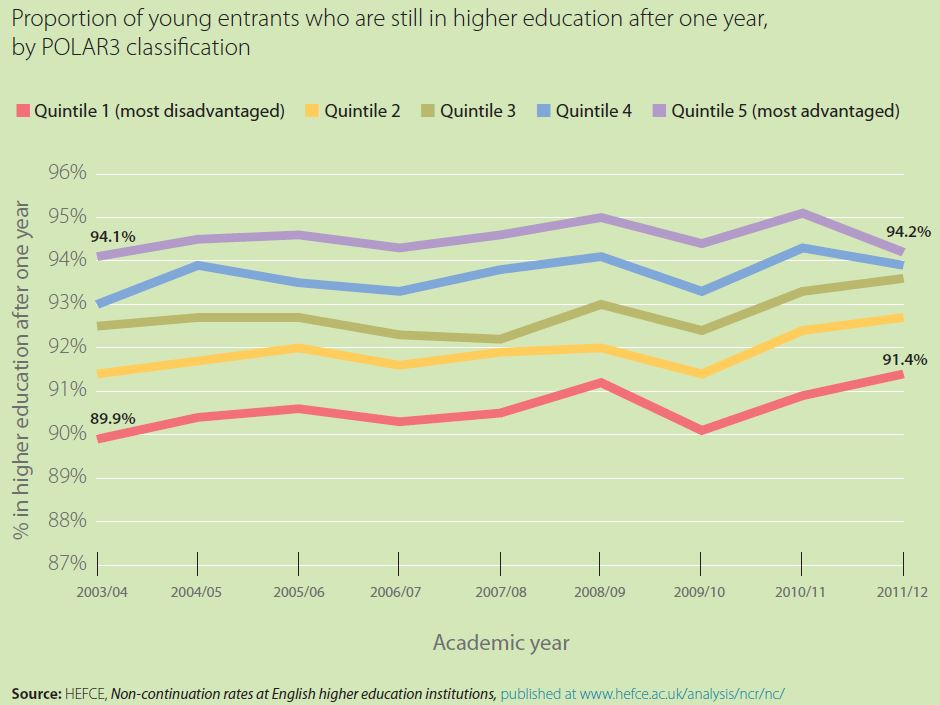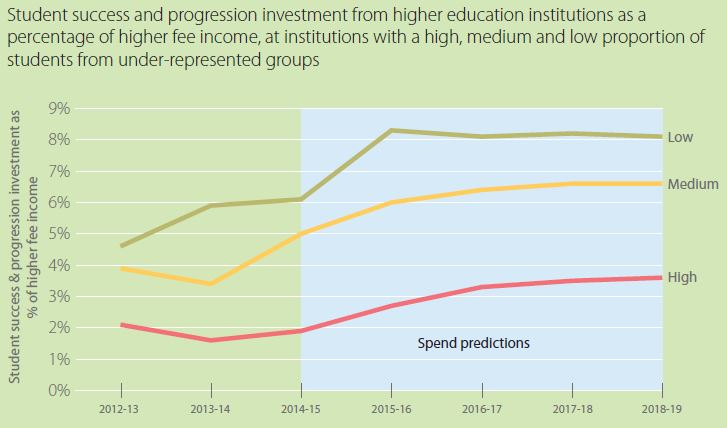It’s ten years since OFFA approved the first access agreements for English higher education. In those ten years access agreements have supported and encouraged numerous improvements in fair access and widening participation. Here, we celebrate ten of those successes.
1. Record entry rates to higher education for young people from disadvantaged backgrounds
More young people from disadvantaged backgrounds are now entering higher education than ever before. Progress has accelerated since access agreements were first approved in 2005, and this has been even more marked since the change in the fees and funding system in 2012, with entry rates among this group now at record levels.

2. Record levels of access to the universities with the highest entry requirements
Entry rates for 18 year-olds from the most disadvantaged group to universities with the highest overall entry requirements are now at record levels. Progress has been particularly noticeable after 2010, coinciding with an increasing challenge to these institutions in OFFA’s access agreement guidance.

3. Better support for students from disadvantaged backgrounds
Access is only meaningful if entrants go on to complete their courses and progress to a good job or further study. This can be more challenging for students from disadvantaged backgrounds than for others. Through our access agreement guidance and negotiations, OFFA encourages universities and colleges to take a “whole student lifecycle” approach: not only improving entry rates but also supporting students to complete their courses, get a degree that reflects their full potential, and prepare for the next step.
This graph shows how record proportions of disadvantaged students are staying on in higher education after their first year. It also shows that the gap in retention rates between advantaged and disadvantaged students is narrowing.

4. Increased commitment to fair access by universities and colleges
Access agreements, approved and monitored by OFFA, give universities and colleges direct responsibility for access, success and progression. This has been fundamental to institutions recognising and committing to their role in promoting fair access and achieving change. The requirement to have an access agreement, with the external scrutiny that OFFA provides, influences universities and colleges to make fair access a strategic priority, and helps staff in widening participation teams to get buy-in from senior managers.
“The introduction of access agreements … has had a positive impact on strategic planning and priorities at an institutional level and has ensured resources for widening participation are ring-fenced” – The uses and impact of access agreements and associated spend, CFE Ltd/Edge Hill University, 2013
5. Underpinning ongoing effort at universities and colleges
Access agreements support universities and colleges in planning for the long term, building partnerships and programmes that develop and grow. Plans and targets in access agreements must be set over a five-year period, and access agreement investment comes from fee income, which is predictable and received by all institutions from all students. Also, access agreement investment is ring-fenced for use on widening participation only.
These benefits are particularly important for universities that have a low proportion of entrants from under-represented groups and therefore have the furthest to go to improve access. This is because the other main source of widening participation funding – the government’s Student Opportunity allocation – is awarded according to the number of disadvantaged students that a university or college recruits and so less of it goes to those that are still working to diversify their student bodies.
6. Ensuring accountability and transparency
Access agreements are published and so is OFFA’s monitoring of them. This holds universities and colleges publicly accountable for their responsibility to improve access. It also enables OFFA to celebrate individual institutions’ progress, or to sanction those that break the commitments they make in their agreements.
7. More tailored, strategic approaches to access
Access agreements have brought about a substantial shift in investment and activity, with universities and colleges not only increasing their investment but also tailoring it to where each one most needs to make progress. OFFA expects institutions that have furthest to go in diversifying their student intake to focus on outreach and to invest a higher proportion of their fee income than those that already have relatively representative student bodies. Meanwhile, we expect those that have high proportions of under-represented groups to focus their access agreements on retaining and supporting those students to complete their courses. The graphs below show the marked divergence in access agreement investment patterns from 2011-12 (the point at which our guidance began to specify these different expectations).


8. Increase in outreach work
When access agreements were first introduced, they concentrated on financial support for students because it was assumed that the barriers to university study for people from disadvantaged backgrounds would be mainly financial. But in the past ten years, as the evidence around which approaches have most impact on access has developed, there has been a shift towards much greater use of sustained, targeted outreach. This is in line with OFFA’s guidance. That means universities and colleges are putting their investment where it will have most impact: engaging with potential students from primary school age upwards to overcome the complex issues of low aspirations, academic under-attainment, poor information and lack of guidance that could otherwise be insurmountable barriers to higher education.

9. Supporting collaboration for greater impact
Access agreements encourage institutions to collaborate with one another to increase efficiency and impact, and to reach out to more potential students than they would have been able to engage with individually. The number of universities and colleges setting one or more collaborative targets in access agreements has risen to 104 (out of 162) in 2014-15. Access agreements also encourage different teams within an institution to collaborate in a whole-institution approach that spans the full student lifecycle.
“The recent focus in OFFA guidance on collaborative targets has prompted the growth of partnerships between selective and inclusive institutions across wider geographical areas.”- The uses and impact of access agreements and associated spend, CFE Ltd/Edge Hill University, 2013
10. Higher profile for the importance of fair access
Our powers as the single focus access regulator approving and monitoring access agreements enable OFFA to keep fair access high on the public agenda. We have used both these processes to champion the success of the sector in improving access and to highlight where further progress needs to be made.
Want to know more?
To find out more about the impact of access agreements, please see our latest annual report and accounts, and the CFE Ltd/Edge Hill University report The uses and impact of access agreements and associated spend.
Tell us how access agreements have helped you to improve access, student success and progression
You can join our celebration of the impact of access agreements over the past ten years on Twitter using the hashtag #accessagreements10.

0 comments on “Celebrating ten years of access agreements”